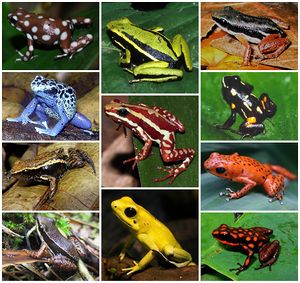Evolution in Family Dendrobatidae (Poison Frogs): Difference between revisions
No edit summary |
No edit summary |
||
| Line 1: | Line 1: | ||
==Introduction== | ==Introduction== | ||
The family Dendrobatidae, part of the class Amphibia, and more broadly, the kingdom Animalia | The family Dendrobatidae, part of the class Amphibia, and more broadly, the kingdom Animalia,,ref>1<ref> are a group of toxic frogs. These animals are commonly referred to as poison arrow frogs, dart poison frogs, or poison dart frogs.<br><br> Frogs within this family are found living in the tropical climates of Central America and the northern portion of South America. They are usually small in size, and are known for their vivid coloration, although there are exceptions to this trait. Their diet consists of ants and mites, which research has suggested are suppliers of the precursor molecules that make up the amphibians toxins. Frogs in this family derive their common name from the Columbian practice of rubbing blow darts on the backs of frogs to coat them in poison for hunting.<ref>[https://animaldiversity.org/accounts/Dendrobatidae/ University of Michigan Museum of Zoology Animal Diversity Web - Dendrobatidae]</ref><ref>[https://amphibiaweb.org/lists/Dendrobatidae.shtml Amphibiaweb.org - Dendrobatidae]</ref><br> | ||
Revision as of 23:11, 9 December 2020
Introduction
The family Dendrobatidae, part of the class Amphibia, and more broadly, the kingdom Animalia,,ref>1Cite error: Closing </ref> missing for <ref> tag[1]

Other examples:
Bold
Italic
Subscript: H2O
Superscript: Fe3+
Evolution
Coloration and Toxicity
Members of the amphibian family Dendrobatidae are considered to be aposematic, meaning their coloration serves as an adverse warning that protects them from predation. For this notion to be true, it is implied that the frogs’ bright appearance and toxicity would have evolved in parallel. Research conducted by Summers and Clough has, in fact, supported that Dendrobatidae are aposematic.
Self Toxin Resistance
Sample citations: [2]
[3]
A citation code consists of a hyperlinked reference within "ref" begin and end codes.

Microbiome
Include some current research, with a second image.
Conclusion
Overall text length should be at least 1,000 words (before counting references), with at least 2 images. Include at least 5 references under Reference section.
References
Edited by Sydney McCallie, student of Joan Slonczewski for BIOL 116 Information in Living Systems, 2020, Kenyon College.
